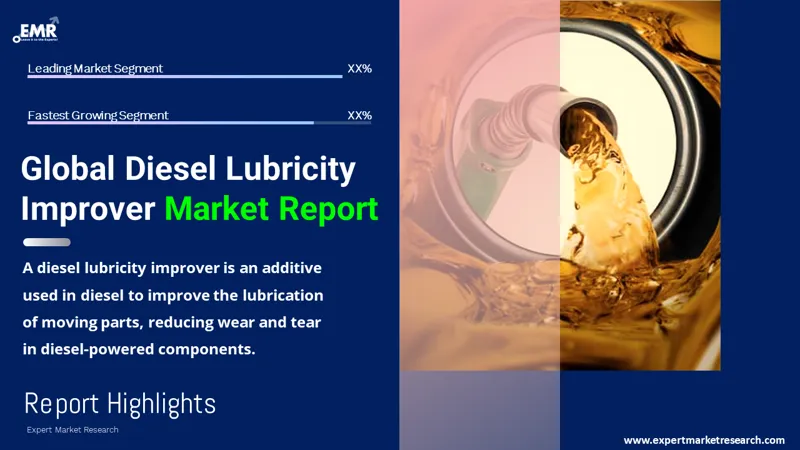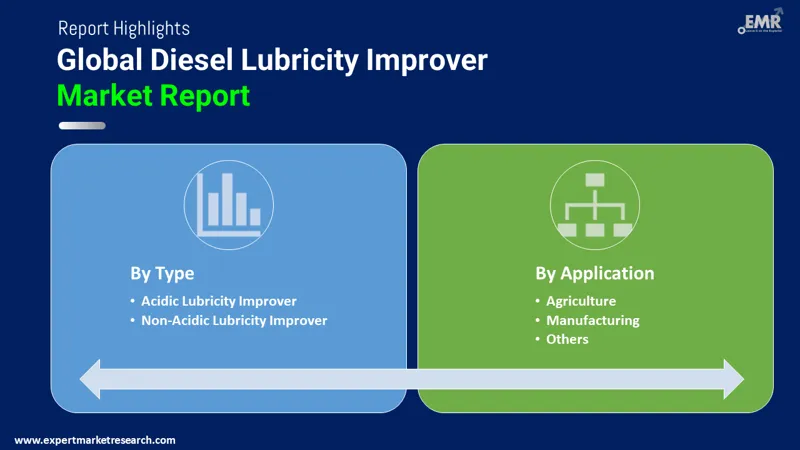
Consumer Insights
Uncover trends and behaviors shaping consumer choices today
Procurement Insights
Optimize your sourcing strategy with key market data
Industry Stats
Stay ahead with the latest trends and market analysis.
The global diesel lubricity improver market size attained a value of USD 3.27 Billion in 2025. The market is further expected to grow at a CAGR of 5.50% between 2026 and 2035, to reach a value of USD 5.59 Billion by 2035.
Base Year
Historical Period
Forecast Period
Compound Annual Growth Rate
5.5%
Value in USD Billion
2026-2035
*this image is indicative*
A diesel lubricity improver refers to an additive for diesel which enhances the lubricity of moving parts within a system, lowering wear and tear in components which use diesel. Diesel lubricity improvers increase the operational efficiency and life service of moving parts, providing time and cost savings in the long-term.

Read more about this report - REQUEST FREE SAMPLE COPY IN PDF
The EMR’s report titled “Global Diesel Lubricity Improver Market Report and Forecast 2026-2035” offers a detailed analysis of the market based on the following segments:
Market Breakup by Type
Market Breakup by Application
Market Breakup by Region

Read more about this report - REQUEST FREE SAMPLE COPY IN PDF
The acidic lubricity improver segment, based on type, accounts for a healthy share of the diesel lubricity improver market. This type of improver contains specialty additives which are acidic in nature and the higher the acidic content, the greater the impact on friction, as well as improved wear resistance. In addition, these additives provide excellent protection to diesel engine components at cheaper rates compared to counterparts along with lower requirement of dosages, which makes them an ideal option for engine maintenance, thereby invigorating the segment’s growth.
Based on application, the automobile sector is likely to be a fast-growing segment in the market for diesel lubricity improver over the forecast period. Diesel lubricity improvers are crucial for automobiles to ensure proper functioning of the engine components of a vehicle, especially the fuel pumps. Hence, the increasing sale of passenger and commercial vehicles across the emerging economies is fuelling the segment’s growth.
The comprehensive EMR report provides an in-depth assessment of the market based on the Porter's five forces model along with giving a SWOT analysis. The report gives a detailed analysis of the key players in the global diesel lubricity improver market, covering their competitive landscape and latest developments like mergers, acquisitions, investments and expansion plans.
Dow Inc. is a leading chemicals company which develops material science solutions, plastics, performance materials, coatings and silicones, and industrial intermediates, among others. The company was founded in 2018 and is headquartered in Michigan in the United States.
TotalEnergies SE is a renowned petroleum company which produces and markets fuels, natural gas, electricity, and is committed towards producing energy that is affordable, reliable, and cleaner. Founded in 1924 and headquartered in Courbevoie, France, this company provides expertise in specialty fluids, natural gas and power, and gas mobility.
BASF SE is one of the largest chemical companies across the world which deals with the production, marketing, and sales of chemicals, plastics, crop protection components, and performance enhancing products. Founded in 1865 and headquartered in Ludwigshafen, Germany, this company provides transportation and industrial lubricants which cater to heavy industrial demands.
*Please note that this is only a partial list; the complete list of key players is available in the full report. Additionally, the list of key players can be customized to better suit your needs.*
Other market players include The Lubrizol Corporation, Innospec Inc., Chevron Corporation, Dorf Ketal Chemicals, Huntsman International LLC, Baker Hughes Company, Liqui Moli, and Ecolab (Nalco Champion), among others.




*While we strive to always give you current and accurate information, the numbers depicted on the website are indicative and may differ from the actual numbers in the main report. At Expert Market Research, we aim to bring you the latest insights and trends in the market. Using our analyses and forecasts, stakeholders can understand the market dynamics, navigate challenges, and capitalize on opportunities to make data-driven strategic decisions.*
Get in touch with us for a customized solution tailored to your unique requirements and save upto 35%!
The market reached a value of USD 3.27 Billion in 2025.
The market is estimated to grow at a CAGR of 5.50% between 2026 and 2035.
The market is estimated to witness a healthy growth in the forecast period of 2026-2035 to reach a value of USD 5.59 Billion by 2035.
Favourable norms of various governments aimed at reducing the carbon footprint by optimising fuel consumption, increasing sale of cars, and rising spending on car maintenance are the major drivers of the market.
The key trends in the market include the advancements in fuel additive formulation incorporation technologies and increasing demand for efficient lubricants in the manufacturing and agriculture sector.
Acidic lubricity improver and non-acidic lubricity improver are the primary types of diesel lubricity improvers in the market.
Automobile, agriculture, and manufacturing, among others, are the major applications of diesel lubricity improvers in the market.
Dow Inc., TotalEnergies SE, BASF SE, The Lubrizol Corporation, Innospec Inc., Chevron Corporation, Dorf Ketal Chemicals, Huntsman International LLC, Baker Hughes Company, Liqui Moli, and Ecolab (Nalco Champion), among others, are the key players in the diesel lubricity improver market, according to the report.
Explore our key highlights of the report and gain a concise overview of key findings, trends, and actionable insights that will empower your strategic decisions.
| REPORT FEATURES | DETAILS |
| Base Year | 2025 |
| Historical Period | 2019-2025 |
| Forecast Period | 2026-2035 |
| Scope of the Report |
Historical and Forecast Trends, Industry Drivers and Constraints, Historical and Forecast Market Analysis by Segment:
|
| Breakup by Type |
|
| Breakup by Application |
|
| Breakup by Region |
|
| Market Dynamics |
|
| Competitive Landscape |
|
| Companies Covered |
|
Datasheet
One User
USD 2,999
USD 2,699
tax inclusive*
Single User License
One User
USD 4,399
USD 3,959
tax inclusive*
Five User License
Five User
USD 5,599
USD 4,759
tax inclusive*
Corporate License
Unlimited Users
USD 6,659
USD 5,660
tax inclusive*
*Please note that the prices mentioned below are starting prices for each bundle type. Kindly contact our team for further details.*
Flash Bundle
Small Business Bundle
Growth Bundle
Enterprise Bundle
*Please note that the prices mentioned below are starting prices for each bundle type. Kindly contact our team for further details.*
Flash Bundle
Number of Reports: 3
20%
tax inclusive*
Small Business Bundle
Number of Reports: 5
25%
tax inclusive*
Growth Bundle
Number of Reports: 8
30%
tax inclusive*
Enterprise Bundle
Number of Reports: 10
35%
tax inclusive*
How To Order

Select License Type
Choose the right license for your needs and access rights.

Click on ‘Buy Now’
Add the report to your cart with one click and proceed to register.

Select Mode of Payment
Choose a payment option for a secure checkout. You will be redirected accordingly.
Gain insights to stay ahead and seize opportunities.

Get insights & trends for a competitive edge.

Track prices with detailed trend reports.

Analyse trade data for supply chain insights.

Leverage cost reports for smart savings

Enhance supply chain with partnerships.

Connect For More Information
Our expert team of analysts will offer full support and resolve any queries regarding the report, before and after the purchase.
Our expert team of analysts will offer full support and resolve any queries regarding the report, before and after the purchase.
We employ meticulous research methods, blending advanced analytics and expert insights to deliver accurate, actionable industry intelligence, staying ahead of competitors.
Our skilled analysts offer unparalleled competitive advantage with detailed insights on current and emerging markets, ensuring your strategic edge.
We offer an in-depth yet simplified presentation of industry insights and analysis to meet your specific requirements effectively.
Share